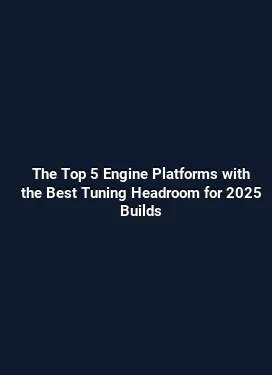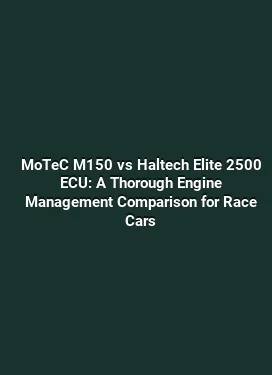The Hybrid Power Play: Tuning Strategies for Torque and Fuel Efficiency in Hybrids
Hybrid powertrains fuse internal combustion engines (ICE) with electric motors to deliver torque more smoothly, improve efficiency, and extend driving range. A successful tuning approach in this domain isn’t about maximizing one parameter in isolation; it’s about orchestrating seamless interaction between propulsion sources, energy storage, and control logic. The objective is to achieve a responsive torque profile under varied load conditions while maintaining economical fuel consumption and battery longevity. This article delves into practical strategies, drawing on real-world scenarios, calibration practices, and the nuanced role of drive modes, battery management, and dynamic torque requests.
Makale içindeki ilk H2 başlık buraya gelmeli

At the heart of hybrid tuning is the art of blending power sources so that neither the ICE nor the electric motor dominates excessively in ways that degrade drivability or efficiency. A thoughtful approach starts with understanding how energy flows during different phases of a drive cycle: initial acceleration, steady cruising, deceleration and regenerative braking, and multicurve hill climbs. Each phase places distinct demands on torque delivery and energy usage, requiring calibration that respects both mechanical constraints and electrical limits.
One foundational concept is to examine the torque bandwidth of the electric motor and the ICE across operating temperatures and speeds. In naturally aspirated or turbocharged setups, the ICE may deliver peak torque within a narrow RPM range, while the electric motor can provide near-instant torque. Aligning these capabilities through a calibrated control strategy yields smoother throttle response and improved acceleration feel without sacrificing efficiency. This alignment often involves tuning the energy management controller to sequence torque contributions so that the ICE runs in a more efficient map during moderate acceleration, while the electric motor fills any gaps with immediate torque during lighter loads or when additional boost is beneficial.
Makale içindeki ilk H3 başlık buraya gelmeli

In practice, the control strategy uses predicted load, vehicle speed, battery state of charge (SoC), and thermal status to decide which propulsion source should contribute most to torque. For instance, during a gentle roll or light throttle, the system may favor electric propulsion to minimize fuel use, while ensuring that the ICE remains ready to contribute if higher power is demanded or if battery temperature falls outside ideal ranges. The tuning objective is to minimize transient power requests that would force abrupt switchover between sources, which can feel like hesitation or surge to the driver.
Advanced tuning often leverages functional boundaries within the ECU (engine control unit) or the e-machine controller. These boundaries define how aggressively the system responds to throttle input, how it ramps torque from both sources, and how it manages energy recapture during braking. By optimizing these boundaries, engineers can reduce parasitic losses, maintain favorable engine efficiency at partial loads, and preserve battery health through controlled charging cycles.
Coordinated Torque Delivery: How ICE and Electric Drive Communicate
Effective coordination hinges on a robust strategy for torque distribution. The goal is not merely to combine two sources but to harmonize their outputs so that the resulting torque curve is linear, predictable, and matched to the driver’s intent. This involves understanding the dynamic response of the system, including electrical limits like motor current, inverter temperature, and battery internal resistance, as well as mechanical constraints such as transmission behavior and clutch engagement in split or series-parallel configurations.
Practically, tuners monitor and adjust several key areas. First, throttle-to-torque mapping must reflect the real-world response of both sources, taking into account turbo lag (where applicable) and electric motor responsiveness. Second, a seamless transition policy is established so that a sudden throttle input does not produce a noticeable drop in torque. Third, torque blending boundaries are defined to ensure the most efficient source is utilized for a given condition, with the electric motor taking precedence in light to moderate loads and the ICE stepping in as load increases or battery SoC drops. This blending is often accomplished with a weighted function that evolves with speed and current torque demand, resulting in a more natural acceleration curve.
From a practical standpoint, calibration sessions use chassis dyno data, real-world road tests, and thermal models to capture how torque delivery behaves as components heat up. A well-tuned system minimizes torque discontinuities that can lead to drivetrain vibration or perceived drivability issues, especially during rapid throttle changes or when starting from a standstill on a incline. The end result is a hybrid powertrain that feels cohesive, with the driver perceiving a single, well-mannered engine character rather than two separate power sources at odds with each other.
Dynamic Drive Modes and Their Influence on Tuning
Drive modes such as Eco, Normal, Sport, and EV+ profiles shape the energy management strategy. In Eco mode, the system prioritizes efficiency, using the electric motor more aggressively and returning energy to the battery through regenerative braking. Normal mode provides a balanced approach, while Sport mode emphasizes performance, increasing throttle response, allowing the ICE to contribute more readily, and sometimes reducing regeneration to maximize available torque. Each mode imposes distinct torque blending rules and heat management considerations, and successful tuning must reflect these operational envelopes without compromising reliability or battery longevity.
In many vehicles, the tuning team will create mode-specific calibration files that tune the thresholds for electricity assist, ICE engagement, and regenerative braking intensity. This ensures predictable behavior for drivers switching between modes, and avoids abrupt transitions that could otherwise feel as if the car is fighting itself for control of torque delivery. Additionally, real-world feedback from drivers—especially in mixed driving conditions like urban stop-and-go versus highway cruising—guides iterative refinements to these maps.
Thermal Management and Its Role in Tuning Stability
Thermal conditions critically influence both the engine and the electric components. Battery temperature affects internal resistance and charge acceptance, which in turn alters the feasible current and thus the maximum torque the motor can provide at any given moment. The tuning process must incorporate thermal models that predict how performance evolves under sustained driving or extended high-load scenarios. Without this, a driver might experience torque droop or reduced performance as components overheat, eroding confidence and drivability.
Engine and inverter cooling strategies are also integral to tuning. If the ICE runs hotter due to aggressive torque blending in hot ambient conditions, it can trigger derating or knock mitigation that compromises power delivery. A mature tuning program accounts for these realities by adjusting the torque blending in high-temperature states, prioritizing efficiency and reliability over peak performance when thermal margins are tight. This holistic approach helps to deliver consistent torque across a broad range of temperatures and climates.
Battery thermal management is equally crucial. In cold weather, the battery exhibits higher internal resistance, limiting current and reducing potential torque from the electric motor. Tuning must anticipate this by favoring the ICE during cold starts or by preconditioning the battery using controlled charging while ensuring that such actions don’t waste energy. In hot climates, aggressive cooling prevents electrical components from saturating, maintaining the integrity of the power electronics and preserving consistent torque response.
Thermal-Proofing the Torque Curve: Practical Techniques
One practical technique is to implement adaptive torque limits that respond to measured temperatures. If motor or inverter temperatures approach a predefined threshold, the system gradually reduces maximum assist, smoothing the torque curve and preventing abrupt drops in performance. Another technique involves dynamic displacement of power between sources according to thermal margins, ensuring that neither component is taxed excessively during demanding driving cycles. This approach helps extend component life and stabilizes performance under repeated cycles of acceleration and braking.
Edge-case scenarios, such as climbing long grades with a heavy payload, require the tuning framework to anticipate sustained high-load conditions. In such cases, a calibrated priority for ICE power can prevent battery sag and protect the electrical system, while still offering electric assist to maintain efficiency at a consistent grade. The end result is a balanced torque profile that feels confident and predictable to the driver, even when the road and weather push the system to its limits.
Energy Management and Regeneration: Optimizing What Goes Where
Efficient energy management is a linchpin of hybrid performance. Regenerative braking recuperates energy and feeds it back into the battery, but the rate and timing of regeneration must be tuned to avoid upsetting the driver’s sense of control. A well-calibrated system uses information about vehicle speed, brake demand, battery SoC, and motor temperature to modulate regenerative torque. The aim is to recapture energy effectively without creating abrupt deceleration or uncomfortable transitions when the driver releases the pedal.
Furthermore, energy management strategies should consider the second-life potential of the battery and the overall mission of the vehicle. For example, a city commuter vehicle may place more emphasis on higher frequent regenerative cycles to maximize daily range, whereas a performance-oriented hybrid might tune regeneration to preserve battery energy for planned electric-only segments or for smoothing pedal response during aggressive launch or track-day scenarios.
To achieve this, calibration teams deploy predictive models that estimate future energy needs based on current driving context. This allows the system to precondition the battery for expected loads and to reserve electrical capacity for critical maneuvers. The tuning process also examines the interaction with brake-by-wire systems and stability controls, ensuring that regenerative torque does not conflict with braking demands or ABS events.
Practical Tune: Regeneration Profiles Across Driving Conditions
In urban driving, a moderate regeneration profile combined with gentle ICE engagement tends to yield the best balance of energy recovery and drivability. On highways, a higher regenerative rate may be used with coordination to minimize battery heating while ensuring that enough charge is available for potential electric-only segments in traffic queues. For enthusiasts, a sport-oriented profile could maintain higher electric assist during launch while ensuring that the ICE remains engaged for sustained power delivery, creating a fusion of smoothness and performance that feels natural to the driver.
Advanced practitioners also monitor battery State of Health (SoH) and cycle life implications. By avoiding repeated deep discharge and compensating for battery aging in the control logic, the tune retains long-term energy availability and consistent performance across the vehicle’s lifespan. All of these considerations come together in a cohesive energy management strategy that emphasizes reliability as much as peak figures.
Diagnostics, Validation, and Real-World Application
Calibration is not a one-off event. It is a continuous process that blends laboratory testing with real-world data collection. In the lab, engineers use dynamometers, thermal chambers, and environmental chambers to simulate a wide range of throttle inputs, speeds, and temperatures. They gather data on torque delivery, fuel consumption, battery current, and component temperatures to build a multi-dimensional model of the powertrain behavior. In the field, ECU logs, telematics data, and driver feedback are used to validate and refine these models under unpredictable conditions.
Validation involves assessing driveability across the entire operating envelope. Engineers look for smooth transitions between propulsion sources, consistency of torque delivery, and stability of fuel economy metrics across a variety of routes and climates. They also verify that the hybrid system maintains appropriate emissions performance and does not trigger unwanted safety or warranty concerns. The result is a tuning framework that remains robust under manufacturing variability and aging, providing consistent feel and reliability for end users.
With the rise of machine learning and data analytics, some teams incorporate adaptive learning into the control strategy. The vehicle can adjust subtle aspects of torque blending and regenerative behavior over time, based on observed driver habits and environmental conditions. This can lead to incremental improvements in efficiency and responsiveness, while preserving a familiar and predictable driving experience for the operator.
Future Trends: Extending Torque Efficiency Through Integrated Systems
Emerging trends in hybrid tuning involve deeper integration between powertrain control, thermal management, and energy storage optimization. Systems are increasingly designed to anticipate long-term wear patterns, incorporate predictive maintenance signals, and balance battery degradation against short-term performance gains. The convergence of advanced materials, higher-efficiency motors, and smarter control algorithms enables hybrids to deliver more torque when needed, with reduced energy waste and better overall efficiency.
Another trend centers on simulation-driven development. High-fidelity models allow engineers to explore countless calibration permutations before testing on physical hardware. This accelerates iteration cycles, reduces development costs, and results in more robust tuning strategies. As vehicles become more connected, data-driven feedback from fleets across diverse geographic regions will further refine energy management, delivering tailored torque and efficiency profiles for different markets and climate zones.
Ultimately, the tuner’s craft lies in balancing driver expectation with system capability. The most successful hybrids feel effortless and confident, offering linear, predictable torque delivery that matches the driver’s intent while squeezing every ounce of efficiency from the hybrid constellation of ICE, electric motor, battery, and control software.






